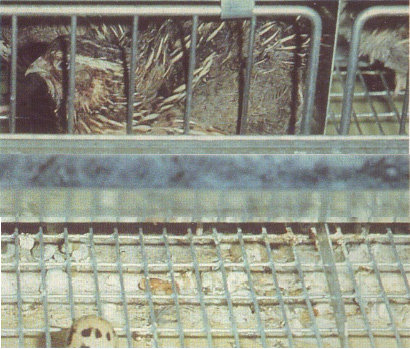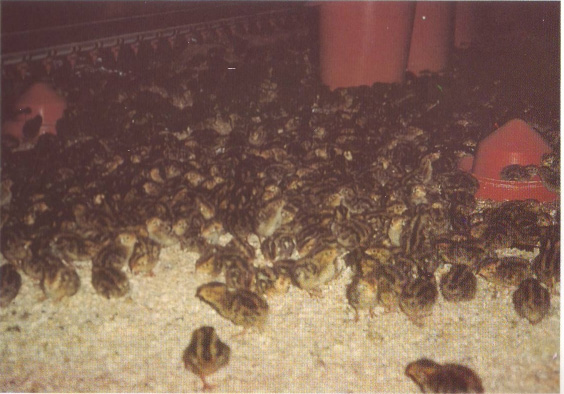TODAY'S FARM ANIMALS
THE INSIDE STORY
Page j
QUAIL
FACTORY FARMING'S SMALLEST VICTIM
 Quail in battery cages. Note the wire flooring and lack of headroom. Photo: A. D. Mills (NRA-Nouzilly) |
Egg Production - Caged Like Battery Hens!
The tiny birds are crammed into battery cages - miniature prisons designed to foil repeated and desperate attempts to escape. Caged quail cannot fulfil natural behavioural patterns like dustbathing and searching around for food. The females have nowhere secluded for egg-laying, and no nesting materials. When alarmed, quail first crouch, then fly upwards, vertically. In cages this can result in severe head injuries, and sometimes death.
Meat Production
Quail reared for their meat are kept like broilers, crammed by their thousands into dimly-lit sheds.
The Suffering of Farmed Quail
In their natural habitat Japanese quail live amongst grasses and bushes, flying over short distances. Like all birds, they are very active. Both intensive systems (cage and broiler shed) cruelly deprive birds of their freedom.
Stress and Aggression
Made aggressive by their horrendous living conditions, quail suffer acute stress, often attacking each other, pecking out feathers and sometimes eyes. Head injuries, which can be lethal, are common. Competition for food can result in injury and, in weaker birds, death from starvation.
Diseases Caused by Intensive Systems
Leg and foot problems, swollen joints and uterine prolapse cause farmed quail much suffering. High mortality from disease and injury is regarded as normal.
Five Weeks Old and Ready for Slaughter!
Quail can live for several years, but the lives of those farmed for their meat are short indeed! By five weeks of age quail weigh between 160 and 250g, and have achieved their most profitable growth spurt. At the slaughterhouse the timid birds are hung upsidedown in metal shackles and electrically stunned, before having their throats cut. On small production units birds may be killed by decapitation or neck dislocation.
Prolonged Suffering for Egg Layers and Parent Stock
Quail reared for eqqs, and those kept for breeding purposes are confined for several month in cages. Amongst the breeders, unnaturally frequent coatings lead to injuries in females.

Please note that the views expressed in this booklet do not necessarily reflect those of the suppliers of the photos of quail.